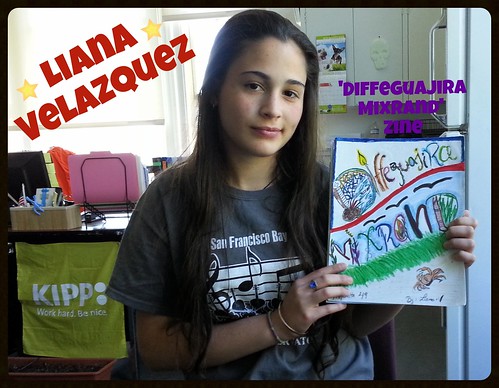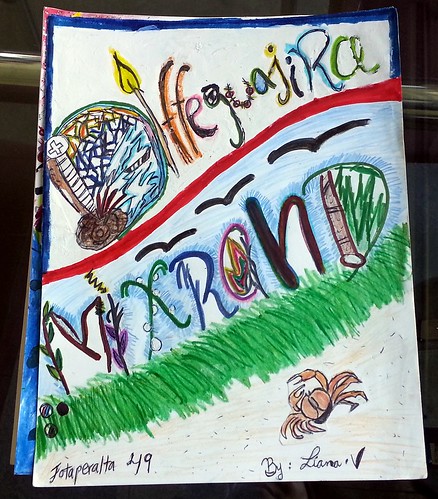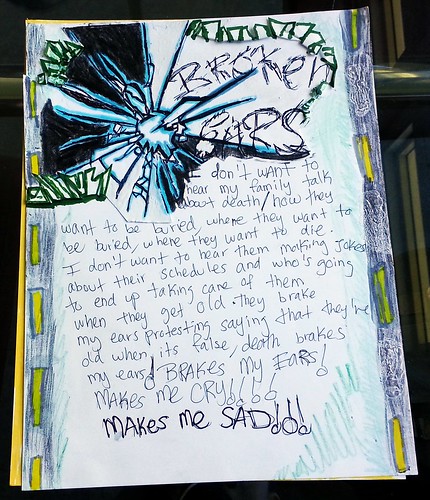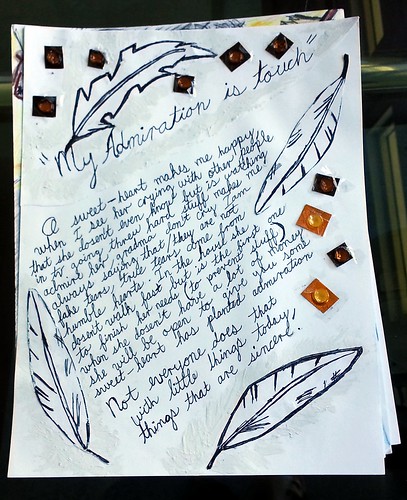Let’s Talk About: Zines In The Classroom—Pros and Cons
 [DESCRIPTION: Liana Velazquez and her zine “Diffeguajira Mixrand” at KIPP San Francisco Bay Academy]
[DESCRIPTION: Liana Velazquez and her zine “Diffeguajira Mixrand” at KIPP San Francisco Bay Academy]
Words and photos by Liz Mayorga, POCZP West Coast Coordinator
I met Liana Velazquez while working at KIPP: San Francisco Bay Academy, a charter school. Liana came in to enroll as a 5th grader. She was shy, but her eyes did not miss a detail. She studied the office as well as the people in it. I soon learned that Liana was not normally reserved. She had just moved to San Francisco from Cuba. Liana was about to start school in a new country, where everything - especially the language - felt foreign. She suffered in school because of the language barrier. Not only did she have a hard time understanding the lessons, but she felt alienated from her classmates. Liana spent a lot of time in the office, where I tutored her. I translated some of her assignments and helped her with her English.
Three years have passed. In that time, I have witnessed Liana’s curiosity and persistence grow even more.
This year, it came through in her writing. Her eighth grade English teacher, Mr. Patrone, encouraged her to continue writing as many stories as possible. He had his students keep a journal, and Liana’s was filled with a series of short stories (both fictional and personal). Patrone and I are good friends, so I always ask him about the kids. He was happy to tell me about Liana’s progress. “It would be awesome to see her and the other kids push their creativity. See where it will take them,” he said.
We brainstormed ways in which to encourage creative freedom, while following the school’s curriculum. I suggested zines. Patrone agreed that a zine workshop would be a perfect way to end the school year, so after the students finished their CSTs, he assigned a zine project. I came in a once a week (for the last three weeks of school) to look through the student’s work and give them feedback. I was impressed by everyone’s projects. They wrote book reviews, song lyrics, created amazing visual art, and told stories about the things that mattered to them. Even the kids who were “too cool” to care became interested in their assignment.
I asked Patrone if I could give one of these kids a zinester spotlight. He checked with the administration to make sure it was okay, and then he told me to look at Liana Velazquez’s zine. I was not surprised to know her zine was phenomenal. What did surprise me was how much her creativity had flourished in such a short amount of time.
Patrone and I set some time aside for me to interview Liana about her zine. Our interview took place on Friday, May 24, 2013.
THE MAKING OF ‘DIFFEGUAJIRA MIXRAND’ ZINE
Liana Velazquez embraces both languages, Cuban Spanish and English, and after three years of living in the United States, dealing with language barriers, and feeling out of place, Liana has gained the confidence she needs to let her creativity shine through. Liana writes stories about love, family, and her ever-changing identity.
Her final 8th grade English assignment was to create a zine, and it proved to be the perfect platform to portray the world, as rich and complicated as she sees it.
She named her zine “Diffeguajira Mixrand,” and she explains: “Diffe stands for different and where I grew up guajiros are really humble (people). They’re poor, but they’re always going to give something to you. You can always trust them, and they’re my people – the people I grew up with.”
[DESCRIPTION: The cover of Liana Velazquez's zine “Diffeguajira Mixrand”]
Each letter in the title forms a symbol. “Here I drew a little boat,” she points to the D, “because that’s what my dad really likes. He doesn’t have that anymore, since he lives here. We used to live by the ocean, and in Cuba, the ocean is beautiful.” Liana dotted the “I” with a candle light. “The candle protected us from the mosquitos,” she said. She looks at the “A” in “Mixrand,” which resembles a butterfly’s wing and says “The butterfly I put there because my mom loves them. I wanted to represent both my parents. And this…” She points to the bottom of the cover, “This is the address of the house I grew up in. I never forgot it. I forget a lot of stuff, like I forget names, and I always forget my address here, but I never forgot my address in Cuba.”
[DESCRIPTION: “Broken Ears,” from Liana Velazquez's zine “Diffeguajira Mixrand”]
Liana combined all of the things that make up her identity and the daily challenges that come with love, family, and acclimating to a new country as young woman. When Liana first attended KIPP San Francisco Bay Academy, she spent her lunchtime in the office, turning to the only people in the school who spoke Spanish - the custodian, the secretary, and her bilingual peers – to translate her assignments for her. Communication was a struggle.
But three years later, Mr. Patrone (the eighth grade teacher), asked Liana and her classmates to write in their composition books every day, and Liana was surprised to see how much she had to say.
“At first, I thought it was too much,” Liana says. “I have all this homework and then I have to write, and I was afraid I couldn’t handle it. But then I got into it. I started writing down things, and I showed it to my cousin. She thought it was good. I showed it to Mr. Patrone and he encouraged me to write more. And I couldn’t stop. I wanted to keep writing. I would stay up late, until 1, 2, 3 in the morning, but it was worth it.”
[DESCRIPTION: “My Admiration is touch,” from Liana Velazquez's zine “Diffeguajira Mixrand”]
Even though Liana already had a love for words and storytelling, this zine project proved to be particularly liberating. The idea of showing her work to other people also encouraged her to put more thought into each piece, and the visual art motivated her to create something amazing. “I was thinking that color was important,” she says, “In the journal, I was just writing. But here, since it’s a zine I know that people do drawings, but I decided to do this because the colors, the red and blue represent flag. And everything represents Cuba and me and everything that I believe in.”
[DESCRIPTION: Excerpt from Liana Velazquez's zine “Diffeguajira Mixrand”]
Liana’s “Diffeguajiro Mixrand” is an example of how zines help teenagers express much more than words and break through creative freedom. With a mixed media approach to writing, teenagers also have a visual and tactile way to share their thoughts. The realm of communication expands, and people capture multiple pieces of their reality.
________________________________________________
WHEN ZINE-MAKING IN THE CLASSROOM GOES VERY WRONG
By POCZP founder Daniela Capistrano
Liana Velazquez’s story is a positive example of what a zine-making classroom experience can be like. Her final 8th grade English assignment at KIPP San Francisco Bay Academy was to create a zine and it was clearly an affirming experience for her. I’m happy that POCZP member Liz was in the classroom to support students, as she knows her stuff, when it comes to zine history and contributions by POC in zine & DIY culture.
Unfortunately, this is not every young person of color’s experience when they are first introduced to zine-making, zine culture and history in an academic setting.
During last year’s Race Riot! tour, I listened to—among other things—stories by POC attendees who shared their first introduction to zines. Depending on their age, digital literacy and other factors, feedback ran the gamut of being introduced to a zine by a friend, at a punk show, through Tumblr or as a classroom assignment.
What I noticed was that the younger the person was (23 and younger), the more likely they discovered zines this way:
1) On the Internet (Tumblr, Facebook, Pinterest, Twitter, Instagram, intentionally searching for a specific title, etc.)
2) At a punk/DIY/house show
3) A friend gave them a zine or brought them to a zine event
4) As a (mandatory or optional) class assignment
From these four responses, a mandatory class assignment was the one that raised the most questions—and concerns—for me, and here’s why:
After one of our academic speaking engagements on the tour, a young woman of color approached and asked to speak with me privately. She didn’t want other students to hear her question, so we moved away from the crowd.
This young woman shared that she was experiencing a lot of anxiety around a classroom assignment given to her by a white male professor at the university where I was speaking with POCZP. She was supposed to make a perzine and include personal details about her “culture” and “experiences as a woman.” I didn’t ask her to clarify what the class was about because it didn’t matter—already this whole situation sounded really problematic.
What I did ask her was if her anxiety stemmed from this being a graded assignment, and she said yes. I asked her if divulging personal information about herself and her family for a graded assignment made her uncomfortable, and she said yes. She looked surprised that I knew these were her biggest concerns, but unfortunately this is not a new story to me.
I then asked her if this was her first time making a zine, and she nodded yes. She leaned forward and whispered, with a nervous look on her face, “How should I make my zine? What should I put it in it?”
That is when I took a deep breathe and gave her a longer and more personalized version of what I am about to share with you all now:
“I am truly sorry that your first introduction to zine-making is through an academic institution. No one should be telling you that there is one set way to make a zine. No one should be requiring you to make a perzine as part of your overall grade.
The only way I could ever see this being justified is if you were a design, journalism, or communications major and enrolled in a class called 'zine-making,’ and you knew that the expectation was that you would be graded on zine-making (within the parameters established by the instructor, which would be clearly spelled out in advance in the syllabus). That zine-making assignment would NEVER be a perzine, because the teacher would know and understand the history and culture of zines, and that grading someone on a perzine is like following a stranger into the toilet and grading the quality of their piss and shit. It is completely inappropriate.
I am sorry that you are experiencing anxiety when you think about making this zine for your class. I wish that instead you were feeling excited and inspired to share your stories, art, insights—and to experiment with art and design. It must be really hard to get into a positive headspace about your first zine, when you know you are going to be graded on detailing personal issues about your life for a white male professor, who has no right to make this a requirement for any class, ever.
I think it’s a huge sign of unchecked privilege for a white male professor to require any student to make a perzine and then grade their output. Your private family life and "cultural” details are none of his damn business. Here is a person who is clearly trying to be “hip” without considering the fact that sometimes, a zine assignment is not the best or most appropriate way to connect with your students or articulate a concept.
So here’s what we know: you’re going to be graded on this zine whether you like it or not. You could fight it—you could take it above his head and explain to the powers-that-be that this teacher has no business requiring you to disclose personal information for a graded assignment, but I’m not going to tell you to do that. You need to do what’s right for you.
But can I make a suggestion about how to approach this, if you do decide to make this perzine for your class to avoid getting a “bad” grade?
Don’t think of this as your first perzine or zine, because it’s not. It’s not really your zine. You are making something for a teacher’s unrealistic and inappropriate expectations. Don’t feel like you have to disclose anything you don’t want to in this zine—think of this like any other assignment you would have in a class where you know that the only way to get a good grade is to do what the teacher thinks is right, and to write that down.
So, what has your teacher indicated is the “right” way to make a zine? If you’re unclear about format, size and content, there are plenty of tutorials online that detail this information. Ask your teacher to name an example of a perzine that he likes, try to find it (or the general equivalent) and then follow that format. This way, you know what he’s looking for. You can find many examples of perzines athttp://zinelibrary.info/english/personal.
Make sure that there is no way he can slash your grade based on design flaws. Give him something that—from a purely technical point of view—falls under the category of “aesthetically pleasing” and only include the most basic personal information you feel comfortable sharing. Don’t compromise yourself (only you know what that would look like).
You could even make up an entirely fictional story and call it personal details from your life—that is what I would do, actually. How is he going to know? Let him believe what he wants to believe—he already believes that it’s acceptable for him to assume that everyone is just like him: totally free to share private details about their lives without any consequences, and grade them based on that presumed freedom.
If you don’t feel comfortable calling your teacher out privately or publicly, don’t. Do what make sense for you. Only you can make that call. Do what you need to do to feel safe.
After you turn in that “made in the belly of white privilege” fake zine and you get the A, you should feel free - if you want - to forget you ever made that zine. That wasn’t your first zine. That was the convoluted outcome of a teacher out of touch with his privilege. A zine is not materiality forced out of you by a white male instructor.
A zine is an extension of yourself. You define that, not him or anyone else.
You don’t have to hate the zine you made for class—you may even end up enjoying the process and the final product. You may decide that this zine does in fact reflect who you are, but don’t put unnecessary pressure on yourself if you can’t make up your mind about it immediately.
Take what you can from the experience of what it’s like to make a zine for a class requirement, but don’t feel bad if you don’t like the zine either, or still feel anxiety when it’s done. What you are experiencing is the totally normal cognitive dissonance one feels when someone tries to quantify the value of your inner world through forcing you to make a perzine and then grading it.
Don’t let this experience of making a zine turn you off from the medium itself, or the practice. Imagine what your first zine experience would have been like if you had been sitting at a bus stop, and next to you was a small little photocopied, stapled book, and inside were hand-drawn comics, copies of photos, and personal stories that made you laugh, cry and think. You suddenly found yourself caring for someone you never met — all because you found their zine.
You took the zine home and placed it on a shelf in your room for safekeeping, and that night you dreamt about the zine YOU would make that weekend at home — the one that someone else might discover one day.
If you decide to refuse to make this zine and take your concerns to the administration, or to make it anyway—I support your choice. But don’t let white male privilege in the classroom damage your perception of zine-making or zine culture. It does belong to you, and you get to define what that means for you—not him.“
Educators: Be in tune with what motivates you to introduce zine-making into your lesson plan. Ask yourself these questions:
1) Why do I care about introducing zine-making and zine culture to my students? What relevant information should I be sharing with them about zine culture and history — and how do my own privileges inform how I prioritize this information?
2) Does it make sense for me to only talk about zines made by white people to a classroom full of primarily students of color?
3) Is it really necessary for me to grade the zines—can they simply get a pass or fail based on completing the assignment?
4) What am I leaving out of my retelling of zine history that is silencing and oppressive to my students of color?
5) If I don’t have much information about zines by people of color, what steps will I take to educate myself BEFORE introducing zines to my students?
COMMUNITY: If you are an educator or youth workshop facilitator who uses zines in the classroom, send us your experiences to poczineproject@gmail.com with "zine teacher” as the subject line. We want to share a wide range of voices on this topic. Also, feel free to leave your comments in a reblog.
Want more? Read POCZP Midwest Coordinator Joyce’s recap of her zine-making experience with an all Native girl scout troop.
_____________________
“Let’s Talk About” is an experimental series by POCZP created to share communal knowledge, resources and reflections on a wide range of topics affecting communities of color.
If you are a person of color—or a white person with a history of supporting POC Zine Project— who wants to contribute to “Let’s Talk About,” submit to poczineproject@gmail.com with “Let’s Talk About” in the subject line.
All submissions to “Let’s Talk About" will be compiled into a zine (print & digital) that will be released by POCZP in December of 2013.
_____________________
SUPPORT POC ZINE PROJECT
If everyone in our community gave $1, we would more than meet our fundraising goal for 2013. If you have it to spare, we appreciate your support. All funds go to our 2013 tour, the Legacy Series and the poverty zine series.
DONATE link via PayPal: http://bit.ly/SHdmyh
97 notes
 ankurri liked this
ankurri liked this jazzimari liked this
boysoprano liked this
plut0rising-blog liked this
beyondtheriot liked this
mouthfulofglass liked this
merenneiti liked this
paradoxnow liked this
deafula reblogged this from missmosnarylime
deafula liked this
penguinace liked this
librarygirl13 reblogged this from kellymce-blog
teachernerdfighterblog liked this
teachernerdfighter reblogged this from libralthinking and added:
Loving this post on so many levels!
 libralthinking liked this
libralthinking liked this missmosnarylime reblogged this from kellymce-blog
kellymce-blog reblogged this from libralthinking and added:
Always reblog this, it is so important.
 libralthinking reblogged this from poczineproject
libralthinking reblogged this from poczineproject worxe reblogged this from girlsgetbusyzine
papercutzinelibrary liked this
daysofpetrichor reblogged this from poczineproject
 nicool liked this
nicool liked this sashanako liked this
sarahsaturn liked this
doughnut-princess reblogged this from poczineproject and added:
My Master’s thesis was about integrating zines into middle school visual arts classrooms. While I understand the points...
sexualassumptions-blog reblogged this from lips-richmond-blog
sexualassumptions-blog liked this
 lips-richmond-blog reblogged this from seam-and-destroy
lips-richmond-blog reblogged this from seam-and-destroy millbeam reblogged this from seam-and-destroy
horiveira-blog liked this
lizmayorga1 reblogged this from poczineproject
quietlyecstatic liked this
3rd-language reblogged this from thecactuscollector
krbee liked this
contusioexistentialis-blog liked this
lixbat liked this
thedfl liked this
seltzerwater liked this
fanniefierce-blog liked this
apinkcoven liked this
millenial-malaise liked this
forestine reblogged this from poczineproject and added:
New fave tumblr.
poczineproject posted this
- Show more notes




